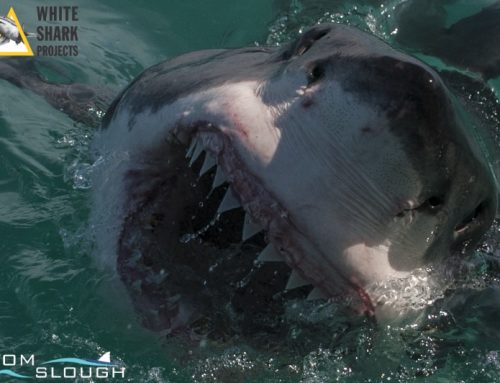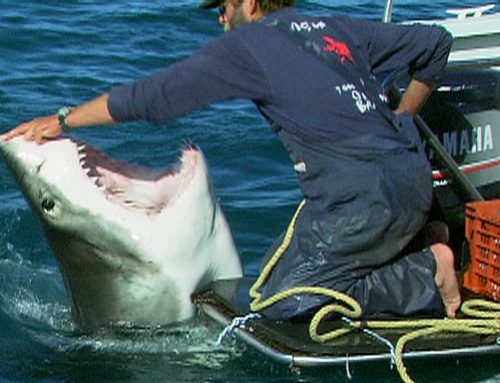Even though White Shark Projects has been running for nearly 30 years, each day is different and each day has new surprises in store for us. On the 6th December 2018 White Shark Projects crew were astounded when an unusual species came up to our cage diving vessel, Shark Team, while we were on anchor in Joubert’s Dam, Gansbaai. Unbelievably, a broadnose sevengill shark paid us a visit and stuck around for the duration of the trip.

Broadnose sevengill shark and bronze whaler shark around our cage diving vessel, Shark Team. Image captured by White Shark Projects videographer – Lee
What is a broadnose sevengill shark?

Broadnose Sevengill Shark, Millers Point, Simon’s Town, South Africa. – Photo © Andy Murch elasmodiver.com
The primitive looking broadnose sevengill shark (Notorynchus cepedianus), also known as a cowshark, is easily recognisable by its seven gill slits (hence the name), while most shark species have 5 gill slits. This species also has a broad head and blunt snout which makes it an odd looking creature. Sevengill sharks have one dorsal fin that is set far back towards the caudal fin (tail). The top of the shark is usually a grey to brown colour with speckles and the belly is a lot more pale in colour. The broadnose sevengill shark can reach up to 3 metres in length.

Four Broadnose sevengill sharks near Simons Town, Cape Town, South Africa – Photo © Tobias Friedrich
Sevengill sharks feed on crustaceans (E.g. lobster and crabs), bony fish, other sharks, rays, seals and even dolphins, as well as scavenging for dead matter. Despite its docile appearance, it is thought that this species can be an ambush predator, capable of short bursts of speed. Incredibly, sevengills are also known to get together in packs to take down their larger prey using stealth tactics. Their top jaw has jagged cusped teeth perfect for grasping prey, while the bottom jaw has comb – shaped teeth adapted for tearing and cutting.
Why does this species look so archaic?

Broadnose sevengill shark – Photo © Chris Fallows
Astonishingly, sevengill sharks are represented in the fossil records by their distinctive comb – shaped teeth dating back to the early Jurassic period, 195 million years ago, making them the oldest of all the shark groups we see today. The seven gill slits is a feature thought to be retained for millions of years from some of the earliest sharks. Sevengills are definitely the most prehistoric looking sharks around today!
The day of the sighting…
We had been on anchor at our dive site Joubert’s Dam for around 30 minutes and were enjoying some beautiful bronze whaler shark sightings around the boat. The bronzies were particularly active that day as the water temperature had risen to over 18 degrees which is warm for our dive site. Then, all of a sudden, I hear our crew member Marius at the back of the boat shouting frantically “WHAT’S THAT?! IT’S A DIFFERENT KIND OF SHARK! IT’S A DIFFERENT KIND OF SHARK!” I ran over and I hear our skipper shout “It’s a sevengill!” So, I eagerly climbed up to the top deck to get a good look at this remarkable species… and there it was…. the strangest looking shark I have ever seen. White Shark Projects volunteers were lucky enough to be in the cage at the time and I asked our volunteer Nadja what she thought when she saw this prehistoric looking creature under the water. Her response was:

Broadnose sevengill shark swimming past the cage of our vessel, Shark Team. Image captured by Jojo Mostert, White Shark Projects volunteer.
“I saw the shark and I was just screaming to David (another volunteer), THERE IS ANOTHER SHARK, THERE IS ANOTHER SHARK!!! IT’S ANOTHER SHARK WITH DOTS!!! It was so exciting!!!”
So, why were we surprised to see one?

Broadnose Sevengill Shark, Millers Point, Simon’s Town, South Africa. Photo © Andy Murch elasmodiver.com
White Shark Projects has been running since 1989 and we have never had a sevengill shark visit our cage diving vessel Shark Team before. Fishermen actually used to catch sevengills around Dyer Island and Geyser Rock. Even though we sometimes anchor around those islands during the winter months, sevengill sharks normally tend to stick to sheltered kelp forests during the day and hunt at night. Surprisingly, when the sevengill shark came up to our vessel on the 6th December, we were actually anchored in Joubert’s Dam, commonly referred to as the shallows as it is between 8 – 10 metres deep, far away from the sheltered kelp around the islands.
When your office is the sea, every day is different and no day is predictable. Here at White Shark Projects we are lucky enough to work in one of the most beautiful places in the world with some of the most spectacular wildlife around us.
The sea loves to surprise us…. I wonder what beauty it holds for us tomorrow….

If you would like to experience the magic of Gansbaai, South Africa – get in touch! bookings@whitesharkprojects.co.za
Written by Georgie Pendell
Marine Biologist at White Shark Projects





